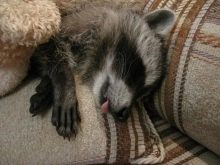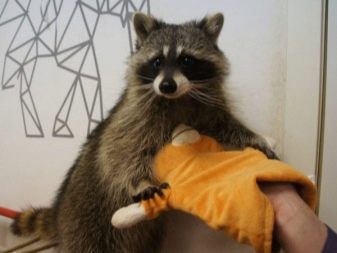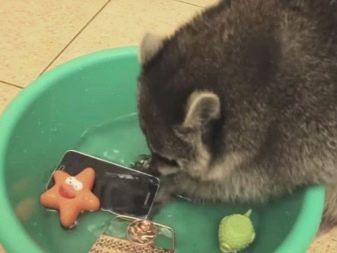Many pet lovers dream of exoticism. Recently, a domestic raccoon has been gaining more and more popularity. This amazing animal has increased activity and high intellectual abilities. However, one should not count on complete submission and affection on the part of the raccoon-raccoon. A wayward pet, even at home, is unlikely to be able to completely get rid of his "animal" instincts.

Character and habits
It is believed that the homeland of a cute and hooligan striped raccoon is North and Central America. However, scientists have found that these animals quickly adapt to any habitat. In the wild, funny animals prefer woodland and the obligatory presence of a pond nearby. The naughty man lives in the hollows of trees, but he will not refuse from the "dwelling" in the form of a mink dug by other animals. In most cases, the raccoon prefers to protect personal space, preventing outsiders from entering its territory.
The distinctive features of this animal include:
- small stature - an adult animal reaches the size of a miniature dog;
- a wide head with a pointed muzzle;
- chic fur with beautiful colors (all shades of black, gray and red);
- long fluffy tail.


The animal also has excellent vision and hearing. A similar feature allows the animal to hunt even in the dark. Raccoons climb trees perfectly, and in case of danger they can accelerate to 20-30 km / h.
As for the nature and habits of a mischievous animal, the owner must first of all understand that the animal will never get rid of its natural instincts.The fact is that fluffy hooligans absolutely do not sit still, constantly studying new places, things. With increased activity, the raccoon-striper explores every corner in the owner's house. In addition, raccoons are not deprived of their waywardness and do not accept voice enhancement from the owner. In such cases, the animal pretends to be “dead", causing excitement in unrestrained households.



Also, this pet is enough vindictive and capable of revenge. Most often this is expressed in aggression against the breeder some time after the "quarrel". Another feature of the character of the striped raccoon is its night walks. Resting in the daytime, with the advent of darkness, a curious animal goes in search of adventure. Note that the hind legs of the animal are so flexible that they allow him to perform various acrobatic stunts while climbing on various surfaces.
It is important to understand that raccoons are extremely clean pets. They love various water treatments. Those who decide to make a home raccoon should not worry about the bad smell.
It is enough to wipe the body and extremities of the animal with a damp cloth, and its fur will become shiny and silky.


Note that during sexual activity, a cute animal is able to show aggression to others for no apparent reason. In this case, experts recommend castration to the males.
In the northern regions, these pets are able to hibernate. They do not leave the hole; their metabolism slows down and their body temperature decreases. According to experts, raccoons living in the southern regions are characterized by year-round activity.


pros
Starting a conversation about the positive aspects of being in a raccoon's house, we note that these animals are quite unpretentious in food and do not require an exclusive diet. Also, the following nuances are attributed to the advantages of the animal.
- “Fuzzy” has high intellectual abilities. He likes to imitate his owner, copying his habits and movements. This feature is extremely amusing to small households.
- Raccoons love fun games and are happy to make contact. The pet does not need privacy and can play with the owner for hours.
- Home raccoon breeders should not worry about the bad smell in the apartment. A clean little animal does not tolerate dirt and gladly accepts water procedures.
- Raccoon strip is distinguished by longevity. At home, the animal can live 15-20 years. Also, a funny animal has good health, which undoubtedly affects the duration of his life.
With proper care, a domestic raccoon is able to live 25 years.


Minuses
Despite all the advantages, a raccoon as a pet is not without some drawbacks. These include the following points.
- The raccoon strip got its name for a reason. The fact is that the animal likes to rinse in the water absolutely everything that comes in its way. Jewelry, expensive items and small household appliances can be used.
- It is unlikely that a breeder can fully tame a wild animal. If the animal gets angry, it may hurt the owner or scratch it.
- Raccoons like to check the contents of the bin, so this capacity is best removed from a conspicuous place.
- To train a fluffy animal to the toilet is almost impossible. Males will definitely mark the territory, in spite of the breeder’s bans.
- The pet needs its own corner in the apartment. However, the dimensions of his home should be of impressive size. Not every breeder can afford to allocate a separate room for a fluffy “friend”.
- Wayward raccoons cannot stand loneliness and constantly require attention. Thus, one of the household must constantly be directly with the animal.


Compatible with other animals
Another significant drawback of a domestic raccoon is its relationship with other pets.The fact is that a wild animal can not be categorically kept with rodents, decorative birds, as well as kittens. A wild animal will perceive them as prey, which will lead to sad consequences.
Raccoon coexists with large animals quite tolerably. However, the pet is unlikely to allow cats or dogs to enter its territory. Even a small bully loves to feast on ornamental plants, so their number in the house with the advent of furry fidgets will significantly decrease.


How to contain?
First of all, you should abandon the cell. A wild animal in captivity will experience extreme stress, which will subsequently lead to its death. The best option would be a spacious aviary on the street. If this is not possible, then the pet is allocated a separate place in the apartment or private house.
Externally, the raccoon's dwelling should resemble a closet, the front wall of which is made of mesh. The side walls are sheathed with moisture-resistant plywood. Sawdust is used as filler. A small bowl for food, a tray and toys are also installed in the pet's home.
House cleaning should be done daily.

Raccoon Raccoon is an omnivorous pet and is not particularly picky about food. His diet consists of the following foods:
- sea fish;
- lean meats;
- nuts
- dairy products;
- fruit
- eggs.


Also raccoons They like to use dry food intended for cats or dogs. Fluffy animal eats 2 to 4 times a day. Note that giving the pet flour products, smoked meats and chocolate is not recommended.
They bathe a home raccoon with the use of special products 2-3 times a year. At other times, the pet can enjoy a shower with warm water. Visits to the veterinarian and timely vaccination are also important for the pet.
Do not forget about the treatment of animal hair from fleas and ticks.


Parenting
Raccoon training should occur without the use of physical force. Otherwise, the animal will become the sworn enemy of its owner. For a wild animal, punishment is a kind of signal for retaliatory action. However, the breeder must win the indisputable authority of the pet, otherwise the wayward raccoon will become uncontrollable.
Education methods are based on the behavior of a furry pet. Obedience is encouraged by your favorite treat or new toy. As for the command "Not", then in this case a plastic bottle will help. When disobeying the owner of a wild animal, it is enough to hit this object on a hard surface, making a loud sound, and clearly pronounce the phrase: “Forbidden!”.


Particularly important is the constant monitoring of the movement of a small pet. All cutting objects from it is better to hide. It is also necessary to ensure that the baby does not swallow anything dangerous to his health.
It is useful for a home raccoon to take walks in the fresh air. For these purposes, you will need habits and a muzzle. To accustom the animal to these accessories is necessary gradually. Walking your pet is best in the morning or evening hours. In hot weather, the animal can receive heat stroke, and severe frosts will introduce it into a inhibited state.

You can find out how to keep a raccoon at home by watching the video below.










